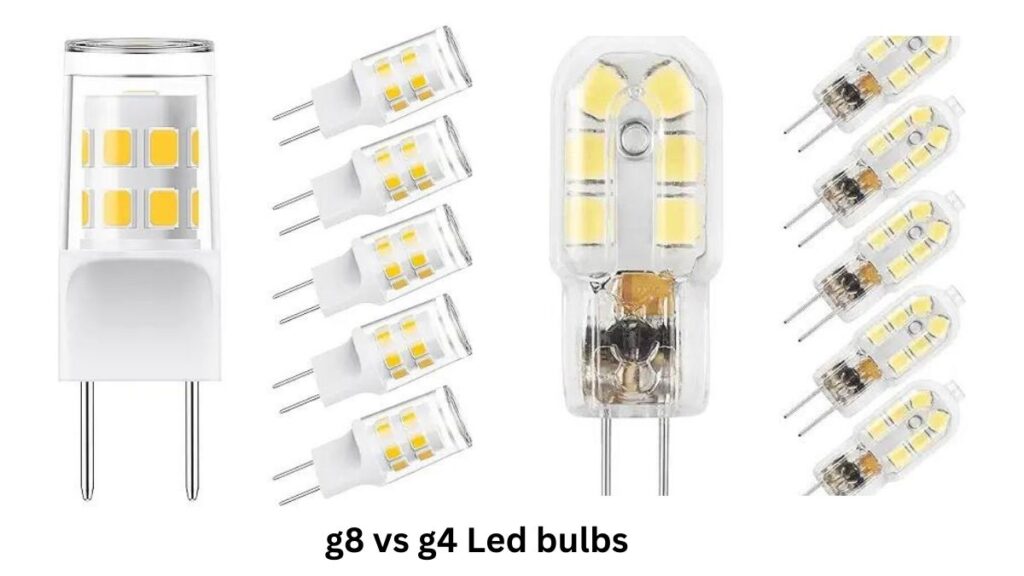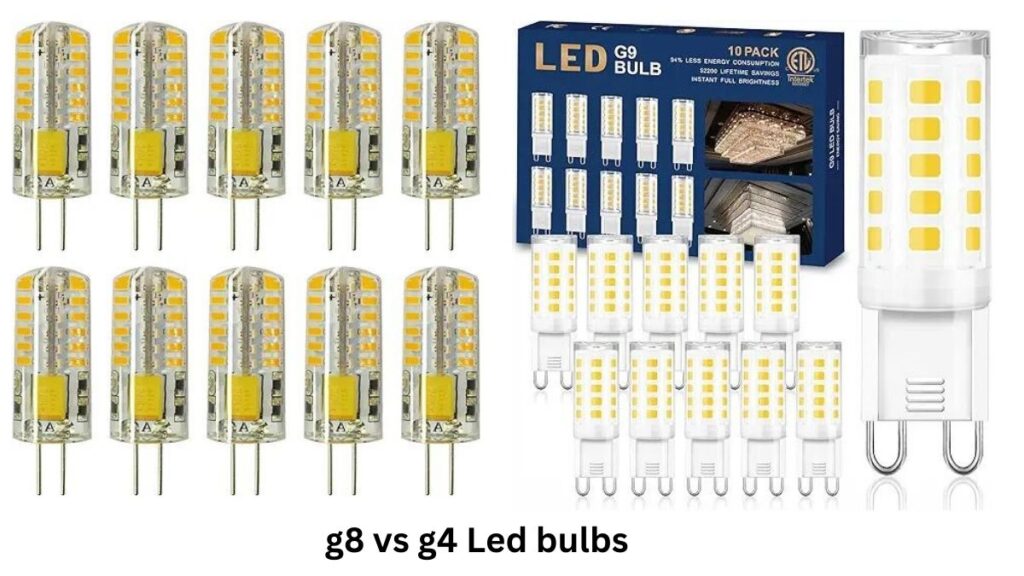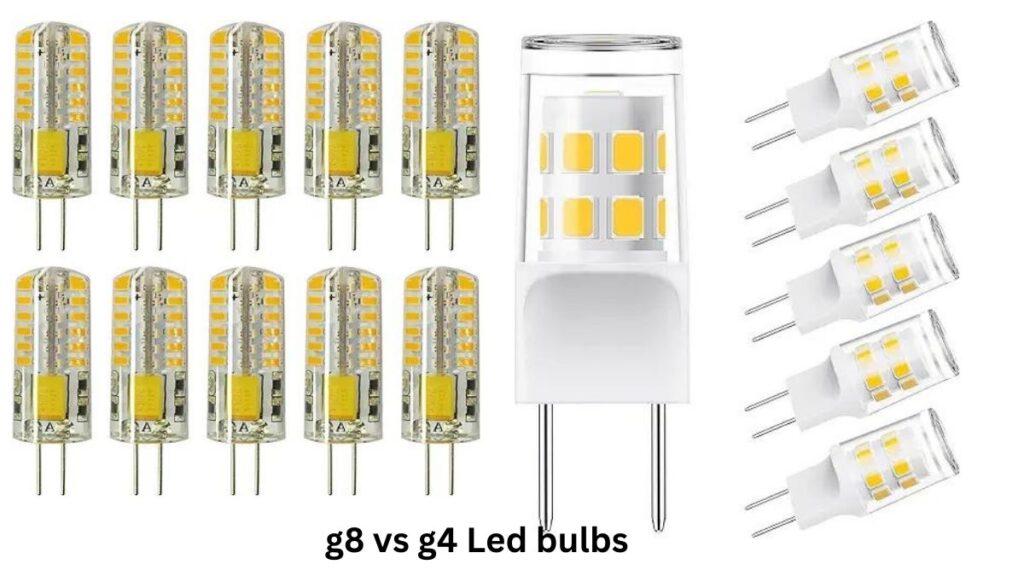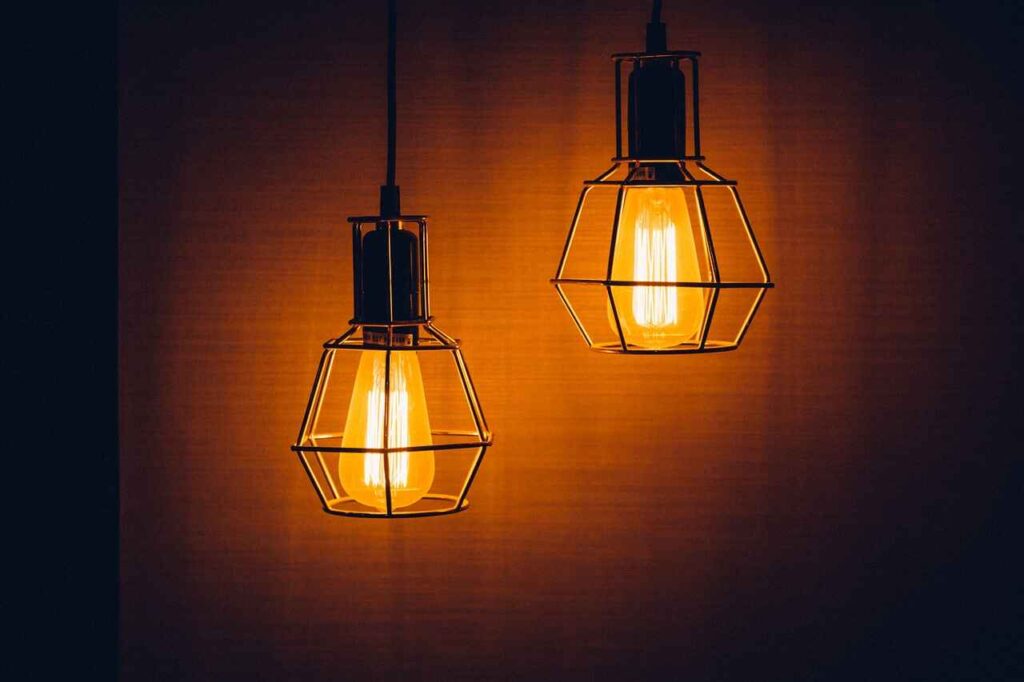Lighting plays a crucial role in how we experience our spaces, whether at home, in the office, or outdoors. The type of bulb you choose not only impacts brightness but also affects energy consumption, cost, and mood. Today, we’ll explore two popular bulb types: G4 vs G5 bulbs. Both have unique features, but which one suits your needs best? Let’s dive into the specifics.

What Are G4 vs G5 Bulbs?
Definition and Basic Characteristics of G4 Bulbs
G4 bulbs are small, bi-pin bulbs typically found in accent lighting and task lighting setups. They usually run on low voltage (12V or 24V) and come in both halogen and LED versions. Their compact size makes them perfect for tight spaces where large bulbs aren’t practical.
Common applications: under-cabinet lighting, pendant lights, and display lighting.
Definition and Basic Characteristics of G5 Bulbs
G5 bulbs are slightly larger than G4 bulbs and feature a 5mm gap between their two pins (hence the name G5). They are often used in fluorescent lighting but also come in LED options. These bulbs typically operate on higher voltages compared to G4.
Common applications: office lighting, linear fixtures, and overhead lighting.
Size and Shape Comparison
Detailed Dimensions of G4 Bulbs
G4 bulbs are compact, usually measuring around 10mm in diameter. The 4mm pin spacing is a key identifier, and their small size allows them to fit into tight, confined spaces.
Detailed Dimensions of G5 Bulbs
G5 bulbs are slightly larger, often used in linear light fixtures. The pin spacing is 5mm, making them distinguishable from the G4. Their longer shape allows for broader light distribution, making them ideal for more open areas.
Visual Differences and Impact on Fixture Compatibility
Visually, the size difference between G4 vs G5 bulbs is evident, with G5 bulbs being larger. This size difference plays a role in fixture compatibility. G4 bulbs fit more compact, decorative fixtures, while G5 bulbs are designed for more extensive, linear applications.
Lighting Performance: Brightness and Color Temperature
Typical Lumen Output of G4 Bulbs
G4 bulbs are typically used in settings that don’t require extreme brightness. A G4 halogen bulb might produce between 200 and 300 lumens, while the LED versions can reach up to 400 lumens, depending on the wattage.
Typical Lumen Output of G5 Bulbs
G5 bulbs, especially fluorescent ones, generally produce higher lumen outputs, often ranging from 400 to 1000 lumens, making them suitable for task lighting and larger spaces.
Available Color Temperatures for Each Bulb Type
G4 and G5 bulbs come in various color temperatures:
- G4 bulbs typically range from warm white (2700K) to cool white (5000K).
- G5 bulbs offer a broader range, from 2700K to daylight (6500K), making them versatile for both cozy and high-brightness environments.

Impact on Mood and Functionality in Different Spaces
The choice of color temperature affects mood. Warm tones (2700K-3000K) from G4 bulbs create a relaxing atmosphere, ideal for bedrooms or living rooms. Cooler tones (4000K-6500K) from G5 bulbs are better suited for task-focused areas like kitchens or offices, where brighter lighting is needed for functionality.
Energy Efficiency and Power Consumption
Average Wattage of G4 Bulbs (Halogen vs LED)
- Halogen G4 bulbs usually consume between 10W to 20W.
- LED G4 bulbs are much more energy-efficient, using between 1.5W and 4W while providing the same brightness.
Average Wattage of G5 Bulbs (Halogen vs LED)
- Halogen G5 bulbs can consume around 25W to 35W.
- LED G5 bulbs reduce energy consumption drastically, using between 6W and 10W.
Comparison of Energy Efficiency Between G4 and G5
In general, LED G4 bulbs are more energy-efficient in small spaces, while LED G5 bulbs offer better efficiency in larger or task-specific areas. Both types provide significant energy savings compared to their halogen counterparts, with LEDs using up to 80% less power.
Potential Energy Savings Over Time
Switching to LED versions of either G4 or G5 bulbs can reduce electricity bills significantly. Over time, the energy savings can outweigh the higher upfront cost of LED bulbs, especially in settings where lights are used frequently.
Lifespan and Durability
Average Lifespan of G4 Bulbs
- Halogen G4 bulbs generally last around 2,000 hours.
- LED G4 bulbs can last up to 25,000 hours, providing a much longer lifespan.
Average Lifespan of G5 Bulbs
- Halogen G5 bulbs last between 2,000 and 4,000 hours.
- LED G5 bulbs can last between 25,000 and 50,000 hours, making them a more durable option.
Factors Affecting Bulb Longevity
Factors like heat, voltage fluctuations, and usage frequency impact how long both G4 vs G5 bulbs last. LED bulbs tend to have a longer lifespan because they generate less heat and use lower power.
Cost Implications of Bulb Replacement Frequency
While halogen bulbs are cheaper upfront, their shorter lifespan means frequent replacements, increasing costs over time. LEDs, though more expensive initially, offer better long-term savings due to their durability.
Installation and Compatibility
Types of Fixtures Compatible with G4 Bulbs
G4 bulbs are compatible with smaller, decorative fixtures such as chandeliers, under-cabinet lights, and pendant lights.
Types of Fixtures Compatible with G5 Bulbs
G5 bulbs are suited for larger fixtures, often used in linear fluorescent lighting systems, making them ideal for offices or commercial spaces.
Ease of Installation and Replacement for Each Bulb Type
Both G4 and G5 bulbs are relatively easy to install. However, switching from halogen to LED versions might require transformers to be compatible with the new bulbs’ lower voltage requirements.
Potential Need for Adaptors or Fixture Modifications
In some cases, adaptors may be necessary when upgrading from halogen to LED bulbs, especially for G4 fixtures. G5 fixtures are more likely to support modern bulbs without modification.
Environmental Impact and Sustainability
Materials Used in G4 vs G5 Bulbs
Both G4 and G5 halogen bulbs contain glass and metal, with some using halogen gas. LED versions, on the other hand, use fewer harmful materials and are more environmentally friendly.
Energy Consumption and Carbon Footprint Comparison
LED G4 and G5 bulbs consume significantly less energy, reducing their carbon footprint. By switching to LEDs, you can contribute to lower greenhouse gas emissions.
Disposal and Recycling Considerations for Each Bulb Type
Halogen bulbs must be disposed of carefully, while LEDs are more recyclable and safer for the environment. Always follow local recycling regulations for proper disposal.
Making the Right Choice: G4 or G5?
Scenarios Where G4 Bulbs Are the Better Option
G4 bulbs are ideal for small, decorative fixtures and spaces where compact lighting is required. They’re perfect for accent lighting, under-cabinet lights, and chandeliers.
Scenarios Where G5 Bulbs Are the Better Option
G5 bulbs are better suited for large, linear fixtures in offices, kitchens, or commercial spaces. If you need bright, uniform lighting, G5 bulbs are the way to go.
Factors to Consider When Making Your Decision
Consider factors like fixture size, brightness needs, and energy efficiency when deciding between G4 and G5 bulbs. LEDs offer the best long-term benefits regardless of the bulb type.
Future Trends in Lighting Technology
As LED technology continues to improve, both G4 and G5 bulbs will become more efficient, brighter, and environmentally friendly, making them smart choices for modern lighting needs.
Conclusion
Illuminating your space is more than just flipping a switch – it’s about making smart choices that balance performance, efficiency, and style. Whether you’re Team G4 or Team G5, the key is to consider your specific needs and the long-term impact of your lighting decisions. Remember, the right bulb can brighten not just your home, but also your wallet and the planet! So, which will you choose to light up your life? The power is in your hands – make it shine!
Related articles:
Hi, I’m Malik Suhail—an SEO expert, web designer, and passionate blogger with 2 years of experience. I specialize in crafting content that is not only informative but also tailored to meet the needs of my readers.
I write about diverse topics, always striving to simplify complex ideas and provide valuable insights that resonate with my audience. Whether it’s about SEO strategies, web design trends, or blogging tips, I am committed to delivering well-researched, practical, and easy-to-understand information.
My mission is to help readers navigate the digital world with confidence and clarity. I believe in adding value through authentic content that inspires action and delivers results.


